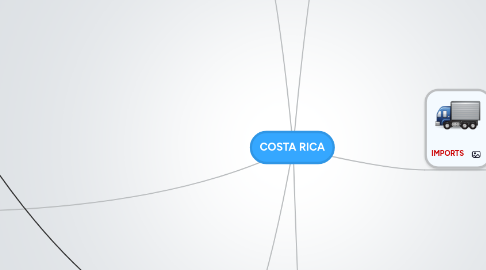
1. INFRASTRUCTURES
1.1. President Laura Chinchilla declared expanding infrastructure as one the the main goals of her administration
1.1.1. By using funds from the Chinese Govenment and the Inter-American Development Bank (IAB)
1.1.2. China is a key part of Costa Rica's Construction plans
1.1.3. Upgrading Roads, Ports, and Railroad infrastructures
2. FACTORIES AND WORKING CONDITIONS
2.1. Foreign Companies are attracted to the Country's location, Political Stability, high number of college graduates, and tax incentives
2.2. Textile Companies Closing
2.2.1. Many believe that the Costa Rican textile industry has lost its competitiveness in Global Markets
2.2.2. BorKar SA
2.2.2.1. Announced Shutdown in March 2013
2.2.3. Confecciones Jinete
2.2.3.1. Shutdown in January 2013
2.2.4. Compania Textiles Centroamericana
2.2.4.1. Shutdown in 2012
2.2.5. Cimer
2.2.5.1. Shutdown in 2010
2.2.6. 10 Textile Companies closed in 2009
2.3. In Central America, Costa Rica has the lowest amount of textile and apparel companies
2.3.1. 44 Apparel Companies
2.3.2. 2 Textile Mills
2.3.3. 1 Services and Accessories Company
2.4. Minimum Wage and Workplace Safety Regulations
2.4.1. Minimum Wage
2.4.1.1. The Constitution provides minimum wage that is set by a National Wage Council, composed of representatives from governemnt, business, and Labor
2.4.2. Workplace Safety Regulations
2.4.2.1. Costa Rican law on health and safety in the workplace requires industrial, agricultural, and commercial firms with ten or more workers to establish a joint management-labor committee on workplace conditions, and allows the government to inspect workplaces and to fine employees
2.4.3. Neither Minimum wage nor Workplace Safety Regulations are always uniformly enforced
3. TRAITS OF COSTA RICA
3.1. BOE
3.2. SOCIAL TRAITS
3.2.1. Life Expectancy
3.3. GEOGRAPHICAL TRAITS
3.3.1. Land
3.3.1.1. 42% Agriculture and cattle raising
3.3.1.2. 38% jungle, forest, or natural vegetation
3.3.1.3. 22% Tourism
3.4. POLITICAL TRAITS
3.4.1. Politically Stable
3.4.2. No Military
3.5. ECONOMIC TRAITS
3.5.1. "Rich Coast"
3.5.2. Gross National Product
3.5.3. Foreign Owned Company's
3.5.4. Strong Technology and Tourism Industries
3.5.5. Highest level of living, as measured by per capita GDP, in Central America
3.6. LABOR FORCE
3.6.1. Female Percentage: 35.4 %
3.6.2. With Primary Education
3.6.2.1. Female: 46%
3.6.2.2. Male: 60.4%
3.6.2.3. Total: 55%
3.6.3. With Secondary Education
3.6.3.1. Female: 27.5%
3.6.3.2. Male: 22%
3.6.3.3. Total: 24.1%
3.6.4. With Tertiary Education
3.6.4.1. Female: 24.4%
3.6.4.2. Male: 14.3%
3.6.5. Manufacturing
4. TRADE POLICIES AND AGREEMENTS
4.1. AGREEMENTS
4.1.1. U.S.- Central American Free Trade Agreement (CAFTA)
4.1.1.1. Began with Costa Rica on January 1, 2009
4.1.1.2. Important factors
4.1.1.3. Textile Related Provisions
4.1.1.3.1. Rules of Origin
4.1.1.3.2. Sourcing rule with Meixco
4.1.1.4. Tariffs
4.1.1.4.1. Central American Common Market
4.1.1.4.2. Exceptions under CAFTA
4.1.1.4.3. Rules of Origin
4.2. CARIBBEAN BASIN TRADE PARTNERSHIP ACT
4.2.1. The countries of Central America now have tariff- free access to the U.S. Market on approximately three- quarters of their products
4.2.1.1. Expired in 2008
4.2.1.2. CAFTA agreement would make the arrangement permanent and reciprocal
4.3. TRADE NATIONS
4.3.1. Unite States
4.3.1.1. two-fifths of exports go to the United States
4.3.2. China
4.3.2.1. Costa Rica maintains a strong trade relationship with China, with which it officially established diplomatic relations in 2007 (after breaking ties with Taiwan
4.3.3. Germany
4.3.4. The Netherlands
4.3.5. Nicaragua
4.3.6. Guatemala
4.4. POLICIES
4.4.1. Controversial Tax Provision
4.4.1.1. Reduce Attractiveness?
4.5. Member of Central American Common Market (CACM)
5. IMPORTS
5.1. Costa Rica was the United States 42nd largest goods importer
5.1.1. Costa Rica Imports from the U.S. totaled $6.1 Billion in 2011
5.1.1.1. 17.0% increase from 2010
5.1.1.2. Down 6.7% in 2008
5.1.1.3. 148% increasse from 2000
5.1.2. Imports approximately 53% of total imports from the United States
5.2. Top five import categories from the U.S in 2011.
5.2.1. Mineral Fuel (oil) ($1.5 Million)
5.2.2. Eletrical Machinery ($1.2 Billion)
5.2.3. Machinery ($540 Million)
5.2.4. Plastic ($397 Million)
5.2.5. Optic and Medical Instruments ($327 Million)
5.3. Agricultural Imports from the U.S. totaled $659 Million in 2011
5.3.1. Coarse Grains ($200 Million)
5.3.2. Soybeans ($118 Million)
5.3.3. Wheat ($64 Million)
5.3.4. Processed Fruits and Vegetables ($30 Million)
5.4. Cloth
5.4.1. Costa Ricans import cloth from the United States in order to export the finished product back to them
6. EXPORTS
6.1. Manufacturing
6.1.1. Crops
6.1.2. Clothing
6.1.2.1. Costa Rica was ranked number 21 out of the top 25 countries exporting apparel to the United States in 2003
6.1.2.1.1. Has since Declined significantly for the past several years, especially when quotas were removed globally
6.2. Costa Rica Exported less in Textiles and Apparel than all of the countries in Central America from 2008-2010
6.3. Costa Rica was the United States 34th Largest supplier of goods imports
6.3.1. Costa Rica exports to the U.S. totaled $10.1 Billion in 2011
6.3.1.1. 16.3% increase from 2010
6.3.1.2. 157% increase from 2008
6.3.1.3. 185% increase from 2000
6.3.2. Approximately 50% of total exports go to the United Stated
6.4. Five Largest Export Categories to the United States in 2011
6.4.1. Electrical Machinery ($6.5 Billion)
6.4.2. Optic and Medical Instruments ($893 Million)
6.4.3. Edible Fruit and Nuts- Pineapples and Bananas ($833 Million)
6.4.4. Spices, Coffee, and Tea ($257 Million)
6.4.5. Machinery ($233 Million)
6.5. Costa Rica is the 20th largest supplier of Agricultural Exports
6.5.1. Fresh fruit (excluding Bananas) ($428 Million)
6.5.2. Bananas and Plantains ($386 Million)
6.5.3. Coffee (unroasted) ($252 Million)
